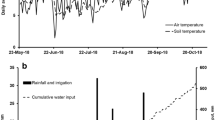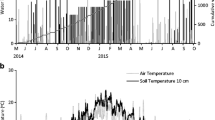Abstract
Nitrogen (N) losses from agricultural land is a major environmental concern, as N leaching can cause eutrophication and nitrous oxide (N2O) is a greenhouse gas. A lysimeter experiment was undertaken to investigate the effects of cattle diet and winter plant growth on N losses from cattle urine patches. The experiment was conducted using intact soil monolith lysimeters, beneath two different pasture or cropping systems: (i) perennial ryegrass/white clover pasture, and (ii) bare fallow after simulated grazing of fodder beet (beet fallow). Two different cow urine treatments (700 kg N ha−1) were applied to each of the crop treatments in June 2017, using freshly collected urine from herds on a diet of either pasture or fodder beet (beet) (supplemented with lucerne silage). Winter plant growth was found to have a large effect on N leaching losses. There were high N leaching losses beneath the beet fallow (335–345 kg N ha−1) compared to the significantly lower leaching loss beneath the pasture (55–121 kg N ha−1). Urine treatment had a significant effect on N losses/transformations beneath the pasture. The pasture with beet urine treatment had 36% lower average ammonia oxidising bacteria (AOB) population abundance, 31% lower soil NO3−–N concentration and subsequently 64% lower NO3−–N leaching losses than the pasture with pasture urine treatment. The lower AOB population and lower average soil NO3−–N suggest a biological nitrification inhibitor effect was present in the beet urine. This study shows the potential of winter plant growth and manipulation of cattle diet in reducing farm N losses.





Similar content being viewed by others
References
Brooks PD, Stark JM, McInteer BB, Preston T (1989) Diffusion method to prepare soil extracts for automated nitrogen-15 analysis. Soil Sci Soc Am J 53:1707–1711
Cabrera ML, Kissel DE (1989) Review and simplification of calculations in 15 N tracer studies. Fertil Res 20:11–15
Cameron KC, Smith NP, McLay CDA, Fraser PM, McPherson RJ, Harrison DF, Harbottle P (1992) Lysimeters without edge flow: an improved design and sampling procedure. Soil Sci Soc Am J 56:1625–1628
Cameron KC, Di HJ, Moir JL, Roberts AHC (2007) Reducing nitrate leaching losses from a Taupo pumice soil using a nitrification inhibitor eco-n. In: Proceedings on New Zealand Grassland Association, pp 131–135
Carey PL, Cameron KC, Di HJ, Edwards GR, Chapman DF (2016) Sowing a winter catch crop can reduce nitrate leaching losses from winter-applied urine under simulated forage grazing: a lysimeter study. Soil Use Manag 32:329–337
Carey PL, Cameron KC, Di HJ, Edwards GR (2017) Comparison of nitrate leaching from oats and Italian ryegrass catch crops following simulated winter forage grazing: a field lysimeter study. N Z J Agric Res 60:298–318
Carey PL, Cameron KC, Di HJ, Edwards GR (2018) Does sowing an oats catch crop reduce nitrate leaching from urine deposition following simulated winter forage grazing?—a growth chamber experiment. Plant Soil 431:37–52
Carlton AJ, Cameron KC, Di HJ, Edwards GR, Clough TJ (2018) Nitrate leaching losses are lower from ryegrass/white clover forages containing plantain than from ryegrass/white clover forages under different irrigation. N Z J Agric Res 62:1–23
Clarkson DT, Hopper MJ, Jones LHP (1986) The effect of root temperature on the uptake of nitrogen and the relative size of the root system in Lolium perenne. I. Solutions containing both NH 4+ and NO3−. Plant Cell Environ 9:535–545
Clough TJ, Ledgard SF, Sprosen MS, Kear MJ (1998) Fate of 15 N labelled urine on four soil types. Plant Soil 199:195–203
Dalley DE, Malcolm BJ, Chakwizira E, de Ruiter JM (2017) Range of quality characteristics of New Zealand forages and implications for reducing the nitrogen leaching risk from grazing dairy cows. N Z J Agric Res 60:319–332
Di HJ, Cameron KC (2016) Inhibition of nitrification to mitigate nitrate leaching and nitrous oxide emissions in grazed grassland: a review. J Soils Sedim 16:1401–1420
Di HJ, Cameron KC, Silva RG, Russell JM, Barnett JW (2002) A lysimeter study of the fate of 15 N-labelled nitrogen in cow urine with or without farm dairy effluent in a grazed dairy pasture soil under flood irrigation. N Z J Agric Res 45:235–244
Di HJ, Cameron KC, Shen JP, Winefield CS, O’Callaghan M, Bowatte S, He JZ (2009) Nitrification driven by bacteria and not archaea in nitrogen-rich grassland soils. Nat Geosci 2:621–624
Di HJ, Cameron KC, Podolyan A, Edwards GR, de Klein CAM, Dynes R, Woods R (2016) The potential of using alternative pastures, forage crops and gibberellic acid to mitigate nitrous oxide emissions. J Soils Sedim 16:2252–2262
Dürr C, Mary B (1998) Effects of nutrient supply on pre-emergence growth and nutrient absorption in wheat (Triticum aestivum L.) and sugarbeet (Beta vulgaris L.). Ann Bot 81:665–672
Fraser PM, Cameron KC, Sherlock RR (1994) Lysimeter study of the fate of nitrogen in animal urine returns to irrigated pasture. Eur J Soil Sci 45:439–447
Hales KE, Cole NA, MacDonald JC (2013) Effects of increasing concentrations of wet distillers grains with solubles in steam-flaked, corn-based diets on energy metabolism, carbon-nitrogen balance, and methane emissions of cattle. J Anim Sci 91:819–828
Hansen JP, Vinther FP (2001) Spatial variability of symbiotic N2 fixation in grass-white clover pastures estimated by the 15 N isotope dilution method and the natural 15 N abundance method. Plant Soil 230:257–266
He JZ, Shen JP, Zhang LM, Zhu YG, Zheng YM, Xu MG, Di HJ (2007) Quantitative analyses of the abundance and composition of ammonia-oxidizing bacteria and ammonia-oxidizing archaea of a Chinese upland red soil under long-term fertilization practices. Environ Microbiol 9:2364–2374
Hutchinson GL, Mosier AR (1981) Improved soil cover method for field measurement of nitrous oxide fluxes. Soil Sci Soc Am J 45:311–316
Judson HG, Fraser PM, Peterson ME, Edwards GR (2018) Specific genotypes of plantain (Plantago lanceolata) vary in their impact on sheep urine volume and nitrification in the urine patch. J N Z Grassl 80:125–128
Kowalchuk GA, Stephen JR (2001) Ammonia-oxidizing bacteria: a model for molecular microbial ecology. Ann Rev Microbiol 55:485–529
Lee C, Feyereisen GW, Hristov AN, Dell CJ, Kaye J, Beegle D (2014) Effects of dietary protein concentration on ammonia volatilization, nitrate leaching, and plant nitrogen uptake from dairy manure applied to lysimeters. J Environ Qual 43:398–408
Luo J, Sun XZ, Pacheco D, Ledgard SF, Lindsey SB, Hoogendoorn CJ, Wise B, Watkins NL (2015) Nitrous oxide emission factors for urine and dung from sheep fed either fresh forage rape (Brassica napus L.) or fresh perennial ryegrass (Lolium perenne L.). Animal 9:534–543
Malcolm B, Cameron KC, Di HJ, Edwards G, Moir J (2014) The effect of four different pasture species compositions on nitrate leaching losses under high N loading. Soil Use Manag 30:58–68
Malcolm BJ, Cameron KC, Edwards GR, Di HJ (2015) Nitrogen leaching losses from lysimeters containing winter kale: the effects of urinary N rate and DCD application. N Z J Agric Res 58:13–25
Malcolm BJ, Cameron KC, Edwards GR, Di HJ, de Ruiter JM, Dalley D (2016) Nitrate leaching losses from lysimeters simulating winter grazing of fodder beet by dairy cows. N Z J Agric Res 59:1–10
Malcolm BJ, Carey PL, Teixeira EI, Johnstone PR, Maley SC, de Ruiter JM (2018) Potential of catch crops to reduce nitrogen leaching in New Zealand winter grazing systems. J N Z Grassl 80:207–214
Malcolm BJ, Cameron KC, Curtin D, Di HJ, Beare MH, Johnstone PR, Edwards GR (2019) Organic matter amendments to soil can reduce nitrate leaching losses from livestock urine under simulated fodder beet grazing. Agric Ecosyst Environ 272:10–18
Maxwell TM, McLenaghen RD, Edwards GR, Di HJ, Cameron KC (2018) Italian ryegrass swards reduce N leaching via greater N uptake and lower drainage over perennial ryegrass cultivars varying in cool season growth rates. N Z J Agric Res 62:1–14
Pachauri RK, Allen MR, Barros VR, Broome J, Cramer W, Christ R, Church J A, Clarke L, Dahe Q, Dasgupta P (2014) Climate change 2014: synthesis report. Contribution of Working Groups I, II and III to the fifth assessment report of the Intergovernmental Panel on Climate Change. IPCC
Ravishankara AR, Daniel JS, Portmann RW (2009) Nitrous oxide (N2O): the dominant ozone-depleting substance emitted in the 21st century. Science 326:123–125
Selbie DR, Buckthought LE, Shepherd MA (2014) The fate of nitrogen in an animal urine patch as affected by urine nitrogen loading rate and the nitrification inhibitor dicyandiamide. Lincoln University, Lincoln
Selbie DR, Buckthought LE, Shepherd MA (2015) Chapter four—the challenge of the urine patch for managing nitrogen in grazed pasture systems. In: Donald SL (ed) Advances in Agronomy. Academic Press, New York, pp 229–292
Silva RG, Cameron KC, Di HJ, Jorgensen EE (2005) A lysimeter study to investigate the effect of dairy effluent and urea on cattle urine N losses, plant uptake and soil retention. Water Air Soil Pollut 164:57–78
Stevenson BA, Parfitt R, Schipper LA, Baisden WT, Mudge P (2010) Relationship between soil δ15N, C/N and N losses across land uses in New Zealand. Agric Ecosyst Environ 139:736–741
Subbarao GV, Rondon M, Ito O, Ishikawa T, Rao IM, Nakahara K, Lascano C, Berry WL (2007) Biological nitrification inhibition (BNI)—is it a widespread phenomenon? Plant Soil 294:5–18
Talbot WD, Cameron KC, Di HJ, Malcolm BJ, Whitehead DC (2019) Effects of adding readily available carbon to soil on nitrogen losses from cattle urine patches. N Z J Agric Res. https://doi.org/10.1080/00288233.2019.1581237
Welten BG, Ledgard SF, Schipper LA, Judge AA (2013) Effect of amending cattle urine with dicyandiamide on soil nitrogen dynamics and leaching of urinary-nitrogen. Agric Ecosyst Environ 167:12–22
Welten BG, Ledgard SF, Judge AA, Sprosen MS, McGowan AW, Dexter MM (2019) Efficacy of different temperate pasture species to reduce nitrogen leaching from cattle urine applied in different seasons: a soil lysimeter study. Soil Use Manag 35:1–11
Woods RR, Cameron KC, Edwards GR, Di HJ, Clough TJ (2017) 15N recoveries from ruminant urine patches on three forage types. Plant Soil 417:453–465
Woods RR, Cameron KC, Edwards GR, Di HJ, Clough TJ (2018) Reducing nitrogen leaching losses in grazed dairy systems using an Italian ryegrass-plantain-white clover forage mix. Grass Forage Sci 73:878–887
Yao B, Di HJ, Cameron KC, Podolyan A, Shen J, He J (2017) Understanding the mechanisms for the lower nitrous oxide emissions from fodder beet urine compared with kale urine from dairy cows. J. Soils Sedim 18:85–93
Acknowledgements
This research was completed as a part of the “Reducing Nitrogen Losses from Farms” programme with principal funding from the New Zealand Ministry of Business, Innovation and Employment (MBIE, Contract C09X1610). The programme is in a partnership between Manaaki Whenua – Landcare Research, Lincoln University, Plant & Food Research and Scion. The authors also wish to thank the technical staff involved in this experiment; Trevor Hendry, Roger Atkinson, Jeneth Hendry, Shelagh Bassett (Lincoln University), Carina Davis (Manaaki Whenua – Landcare Research), Steven Dellow (Plant & Food Research), the Ashley Dene Research and Development Station staff, and Dave Saville (Saville Statistical Consulting Ltd) for advice and guidance with statistical analysis.
Author information
Authors and Affiliations
Corresponding author
Additional information
Publisher's Note
Springer Nature remains neutral with regard to jurisdictional claims in published maps and institutional affiliations.
Electronic supplementary material
Below is the link to the electronic supplementary material.
Rights and permissions
About this article
Cite this article
Talbot, W.D., Malcolm, B.J., Cameron, K.C. et al. Cattle diet and winter plant growth effects on nitrogen losses from cattle urine patches. Nutr Cycl Agroecosyst 116, 365–379 (2020). https://doi.org/10.1007/s10705-020-10050-4
Received:
Accepted:
Published:
Issue Date:
DOI: https://doi.org/10.1007/s10705-020-10050-4




